Eastern tale of Roscosmos
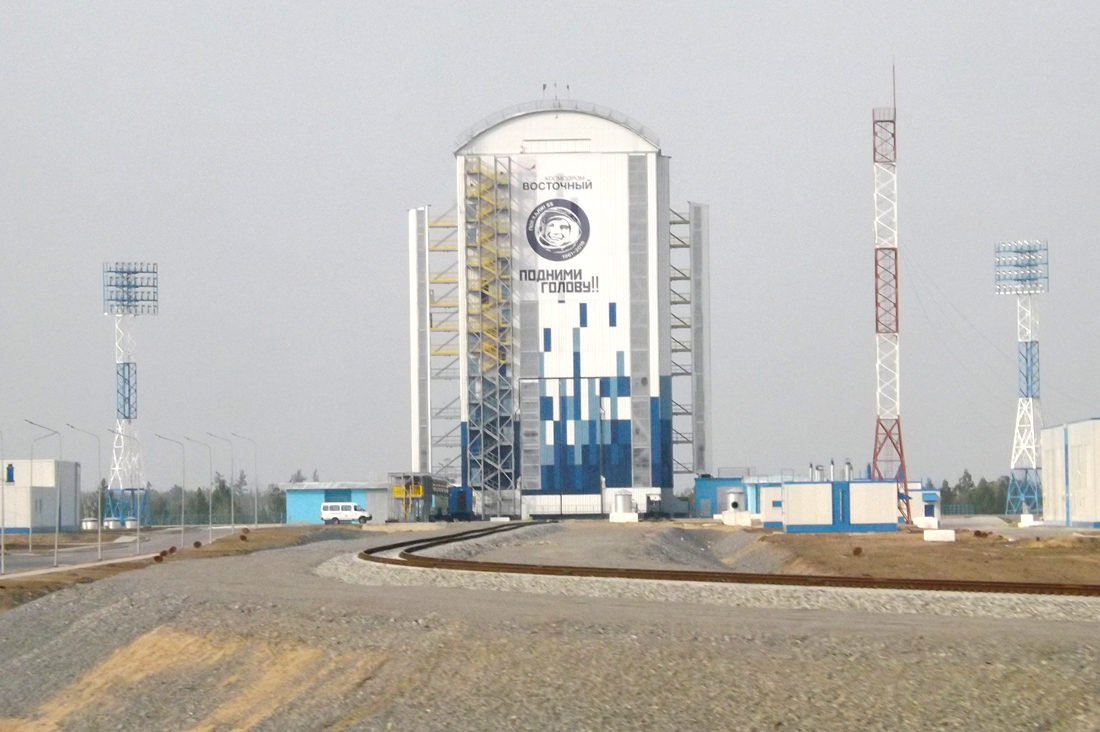
In May, he first visited the Vostochny space center. They did not take the rocket for launch, so I found the spaceport in a "sleepy" form. Nevertheless, what he saw did not disappoint. Despite organizational difficulties, deadlines, scandals and noise in the press, builders and Roskosmos managed to build a high-quality and modern facility. Now I want the spaceport to start more often, this is important both for Russia and for the Amur region in which it is located.
Now everything is more detailed.
')
The first sensation that appeared in Blagoveshchensk, even before arriving at the East - Amur Region, is almost not ready for the cosmodrome to fall on it, like from space. Neither industry, nor culture, nor education have ever done anything for space, and here hop, the region has become the most cosmic, if not in the country, then in the Far East for sure. Now, both the local administration and education, with the support of the SSCC and Roskosmos, in a hurry, fill all neighborhoods with cosmic meanings. Space classes are opened in schools, space monuments and panels appear on the streets, space specialties are being opened at Amur State University, although the department has not yet been recruited for teaching staff. Therefore, students are sent to finish their studies at the Moscow Aviation Institute in Moscow, and some even return to work in the East.
Actually, I got on this tour as a space explorer, to communicate with students and schoolchildren. For this, in Blagoveshchensk and Uglegorsk for the second year the local government and Roskosmos organize a festival “Cosmofest” for students.
By the way, life hacking: if you graduated from an engineering specialty, you are young and a native of the Amur Region - submit documents to the cosmonaut detachment. Now this region does not have its own cosmonaut, but it is in great demand for maintaining cosmic status, and Roskosmos understands this.
Blagoveshchensk does not make an impression of a prosperous city, only along the border coast of the Amur is built up of luxury housing and a beautiful embankment was built to look beautiful from China.

And the first thing that they say only to those who arrived in Blessing is how a Chinese village on the other bank in a few years turned into a huge city in the evenings shining with illumination like Las Vegas.
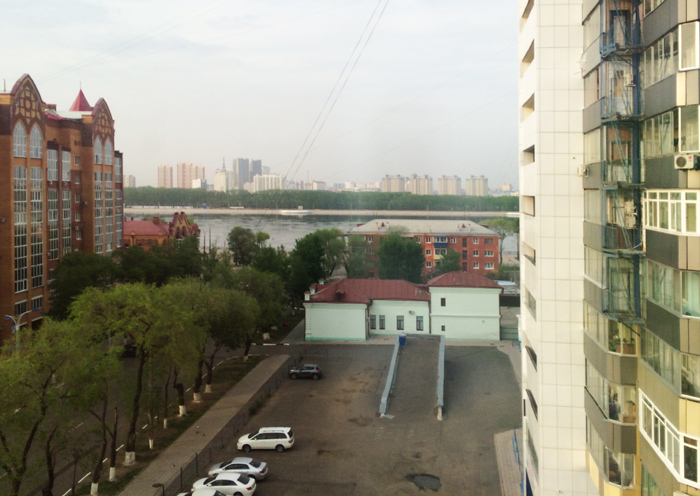
For the sake of interest, I looked at the satellite data on the growth of the city and the objective data is not so impressive. In twenty-five years, the area has grown by about two times. Apparently on the other side, similar activities are being carried out to add epicity to the state facade.
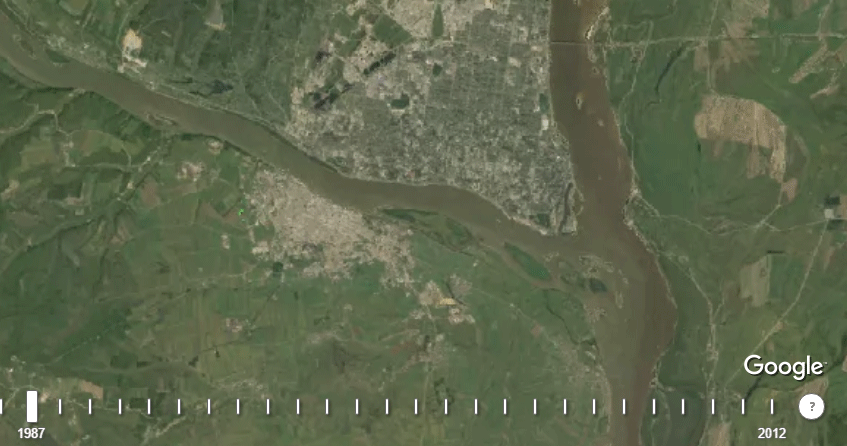
The road to the East stands out for its quality and manufacturability - although in fact it is just a good two-strip.
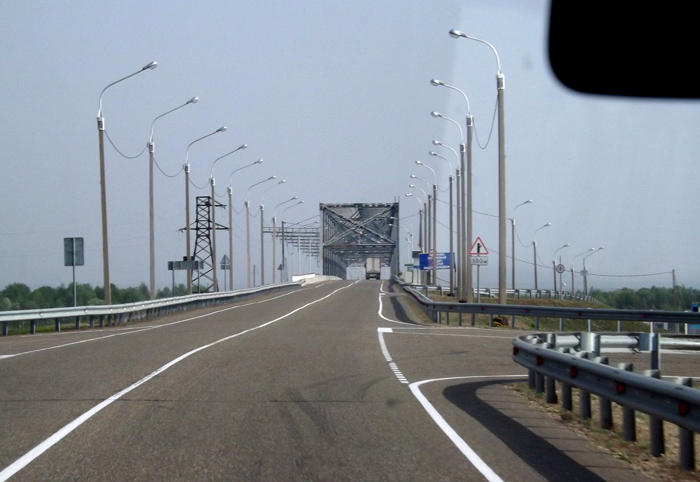
To the credit of the local authorities, it is worth mentioning the training carried out before the launch of the rocket. For convenient viewing of the April flight of the “Union” along the route, several extended parking lots were allocated, marking banners were installed along the roads, and they actively covered this training in the press . That is, from the point of view of the convenience of tourists who want to see the rocket flight, in the Amur Region everything has been done better than at Baikonur. If you wish, you can find some more interesting objects on this route, but no longer on space subjects, so we didn’t stop for us.
On the second day we reached Uglegorsk. This is a typical border village with part of the Strategic Missile Forces. There was a little more space, although the military.
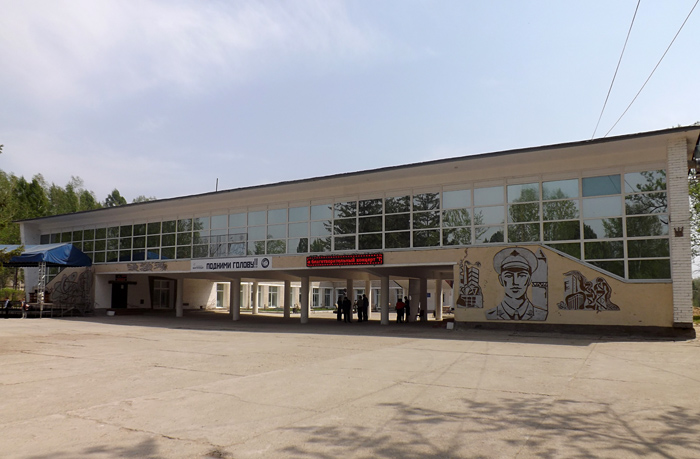
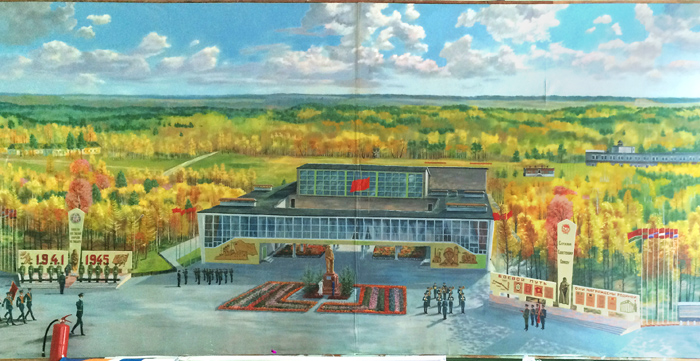
But even now they are hastily filling the streets with civil space themes.
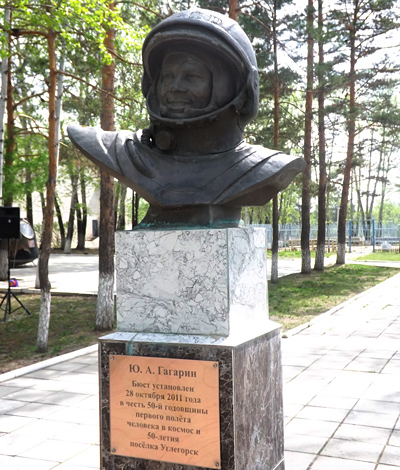

There is even a souvenir stall, waiting for the influx of tourists.

On the occasion of the festival, cosmonauts and other distinguished guests came to the village, so the organizers set up a guard of honor.
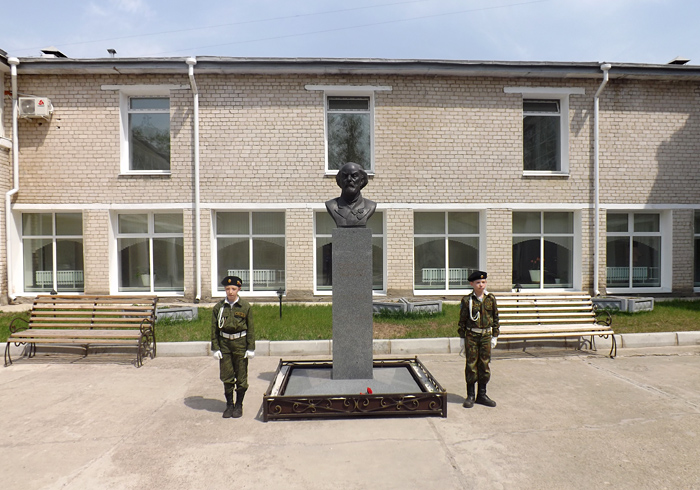
Came up to the guys at the monument, asked:
- Do you know who this is?
- This is the inventor of astronautics.
It is evident that the efforts in space education were not in vain. By the way, it pleases that they immediately took up the younger generation, the future for them.
Although the past still looks out of thick spruce branches.
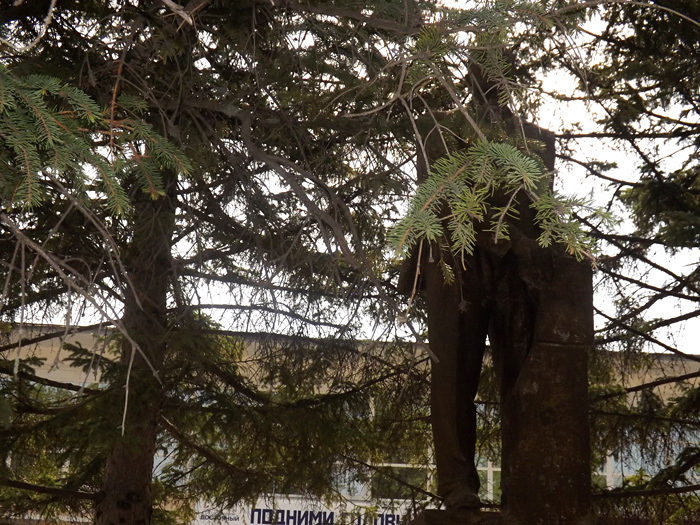
After the railway station, the East itself begins - the patrimony of Roskosmos.
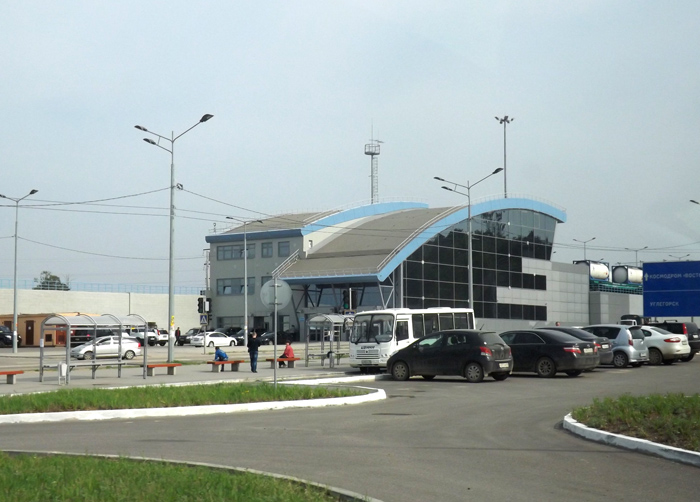


From here, to the cosmodrome, there are another twenty kilometers, but along the way along the railway, tanks with rocket fuel and diesel locomotives of the Center for the operation of ground and space infrastructure are already encountered.
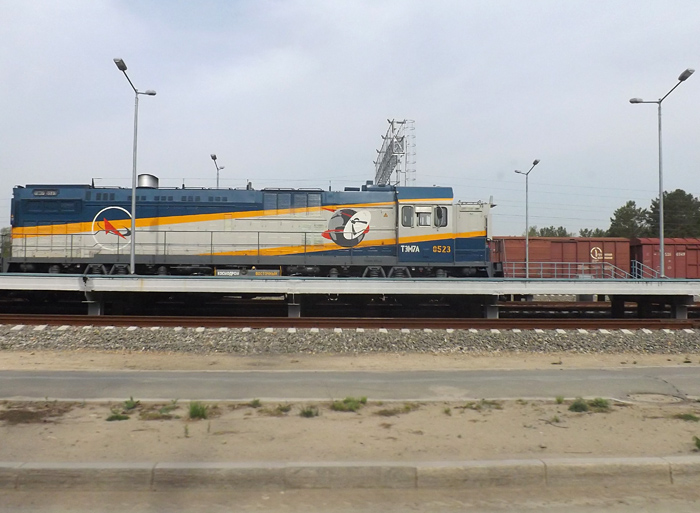
Finally, got to the spaceport. The launch pad is still a few kilometers away, and we are shown the Assembly and Testing Corps, where we assembled a rocket and prepared it for launch.

The building is, of course, of cyclopean scale, and looks quite high-tech.

During the construction of the cosmodrome, the local climate was taken into account, especially in the cold season, therefore the hull is designed so that all processes take place under the same roof - on the one hand there are trains with missile elements and satellites, and on the other hand there is a rocket ready for launch.
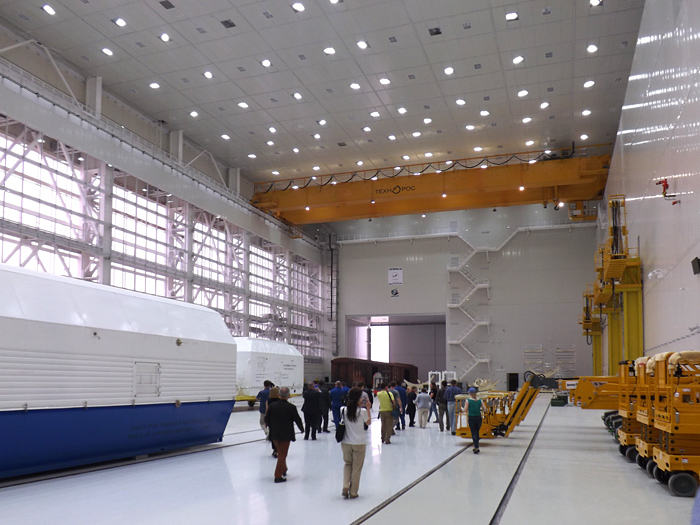
So far all this is intended only for the Soyuz-2 missile in an unmanned version. It is quite likely that the manned spacecraft Soyuz will never be here - they plan to immediately launch Angara launches with the Manned Federation .
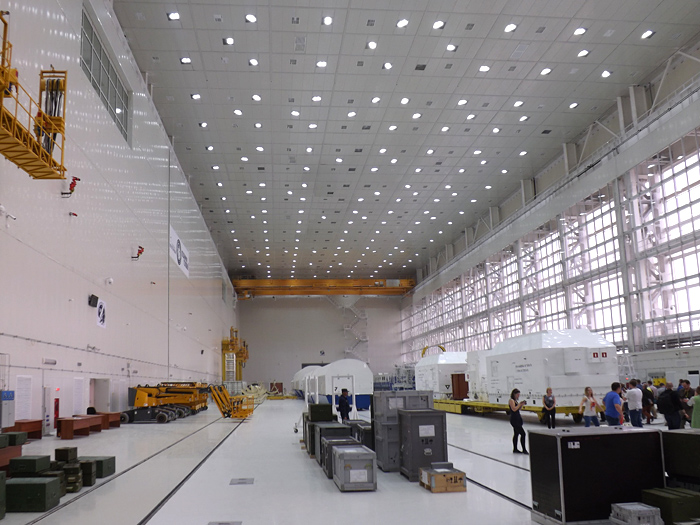
Inside the MIC there are still empty containers from the rocket and satellites.

The quality of the erected building inspires respect. Made really all soundly. Everywhere advertising banners of manufacturers and contractors are striking.

Even pride is felt, with which the performers signed their works.

Speaking of space technology. Somewhere applied and quite time-tested solutions, such as captures of the rocket conveyor are lined with completely natural felt.


The floors are so bright that it is a pity to walk in shoes or at least without shoe covers.
In general, the requirements for cleanliness are strict here, but, as I understand, they understand that the next rocket will not come here soon, and it is easier to clean up before the next launch than to spend more than a year on boot covers and bathrobes. We were allowed out of the street without special reservations about cleanliness.
It is seen that the first launch did not pass for equipment in vain.
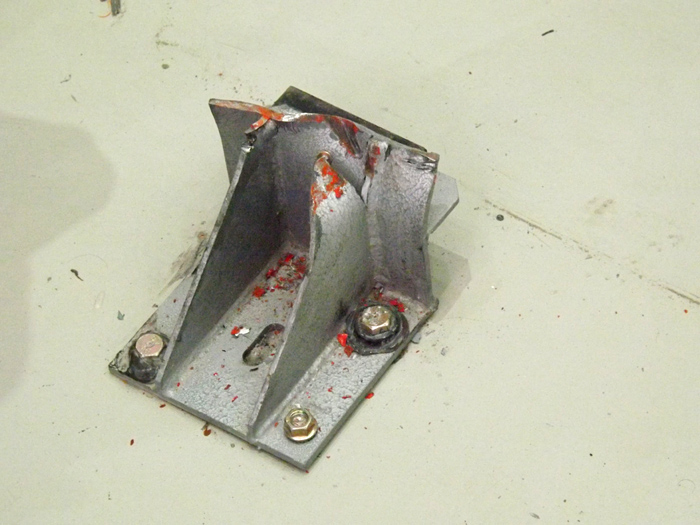
The construction of the Oriental is usually compared with another “building of the century” - Olympic facilities in Sochi, and there are some similarities, for example, this giant hangar is easy to imagine with figure skaters, although its task is to move the rocket elements and satellites from the shop to the shop.
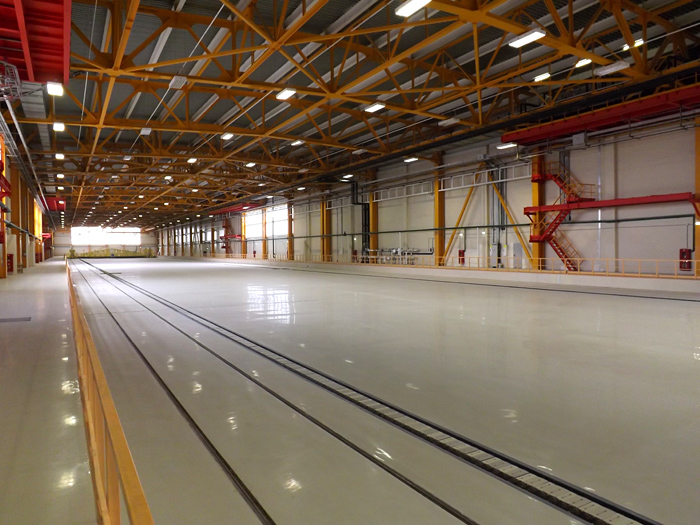

The next building is such a kind of “hotel for satellites”. The place where the spacecraft pass the last checks and prepare to launch.
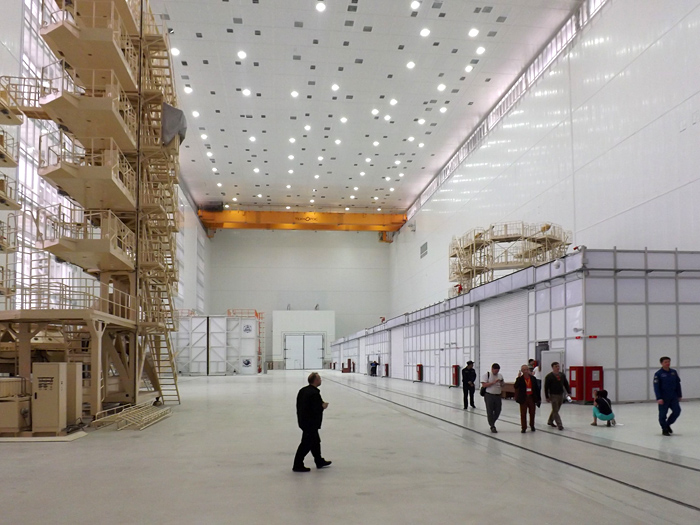
Here, each spacecraft manufacturer has its own “number”.
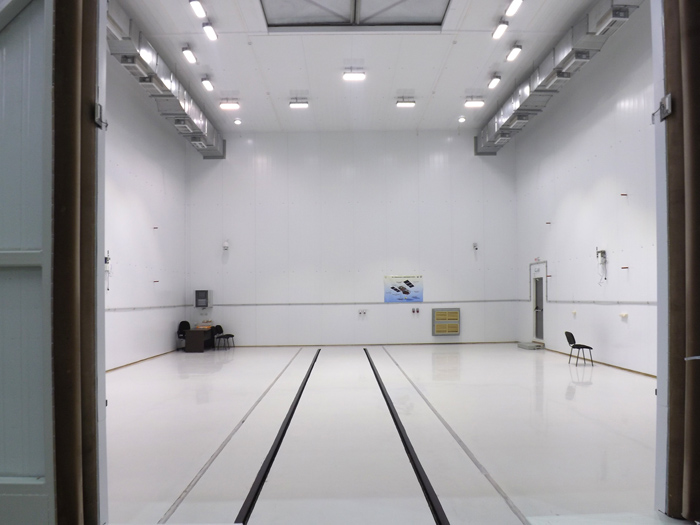
I have not considered separate issues for foreign tourists, most likely they will be visiting NGOs. Lavochkin - the manufacturer of the “Fregat” upper stage , which is used for launching satellites into working orbits.
They even showed us a corps, the existence of which they try not to spread beyond the limits of the cosmodrome - the refueling one.
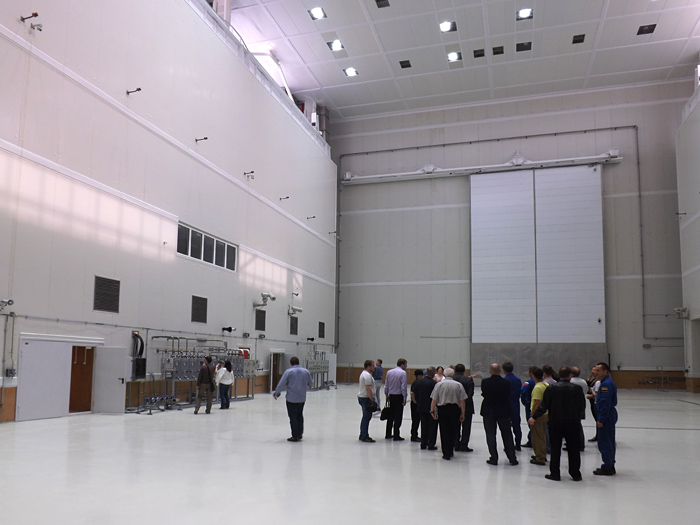
Even when the decision was made to build a cosmodrome, local environmentalists raised a fuss about toxic rocket fuel. In order to reassure them, the rocket engineers had to carry out a lengthy educational work explaining that there would be no protons on the Eastern fuel, and that oxygen-kerosene Soyuzs are not more toxic than passenger planes. True, these enlighteners kept silent, and perhaps did not know that the fourth stage of the “Union” is an accelerating unit with quite toxic fuel, and more often than not “chemistry” is poured into the satellites. True, these engines are launched only in space, so everyone is interested in getting there.
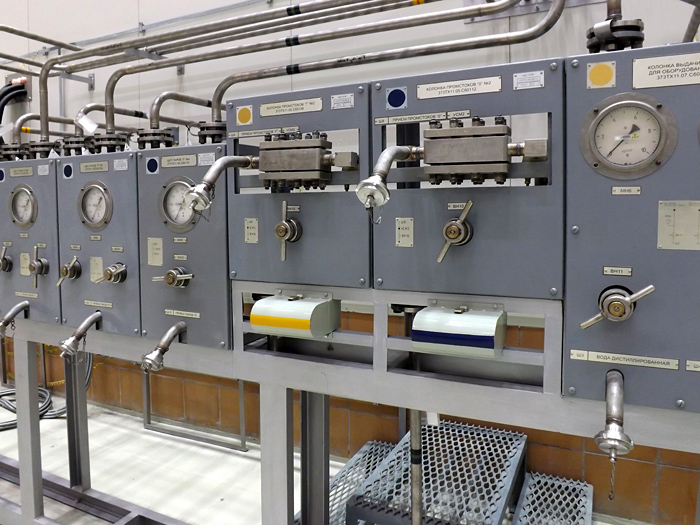
Due to the toxicity of the fuel, refueling of satellites and accelerating units is a complex and dangerous process that people carry out in special space suits. This is how it looks at the similar Kourou space center on the other side of the globe.
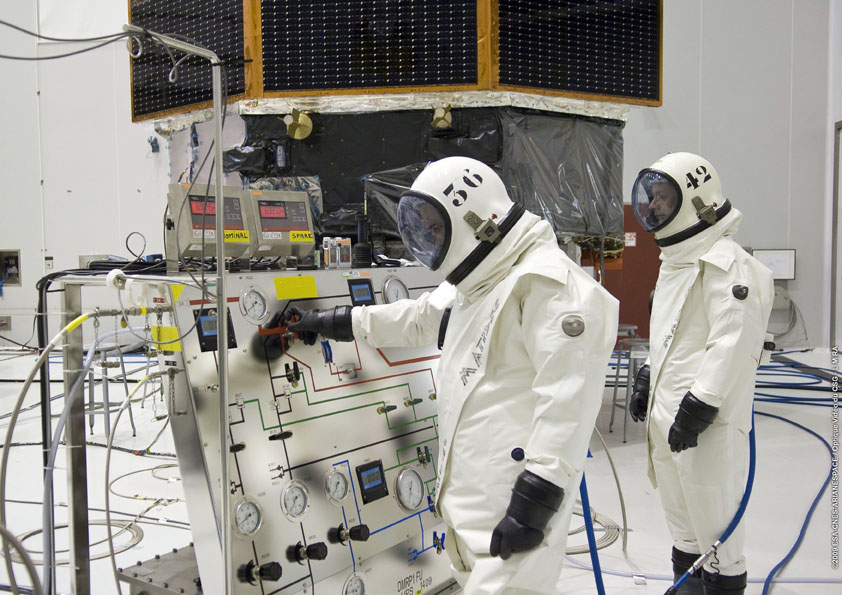
In the East, along the walls of the filling station, sensors are installed that catch the smallest concentration of toxins and warn operators.
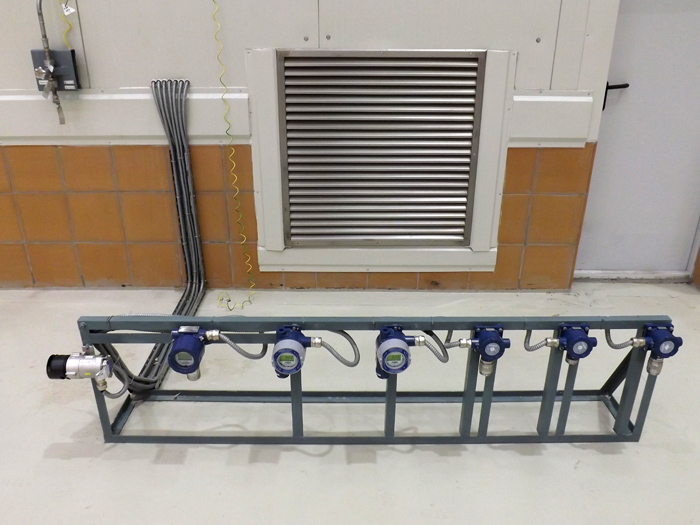
According to experts, the first refueling was normal without leaks and incidents.
Although there was a suspicious stain on the floor, but I suppose if it really turned out to be rocket fuel, I would not have been able to tell about it.
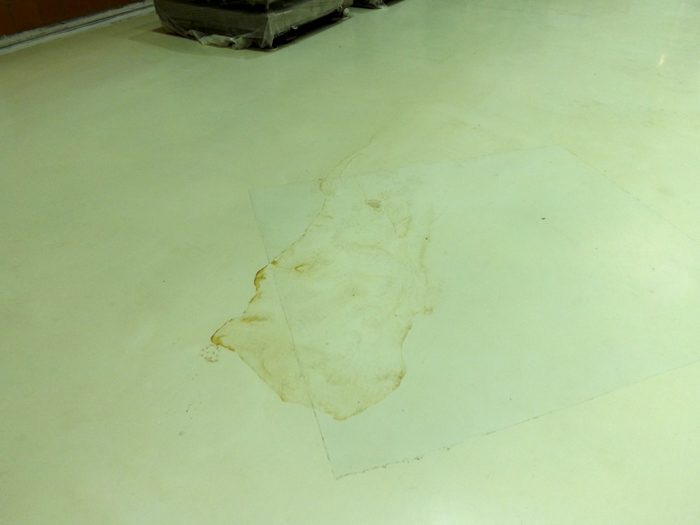
In the vicinity the construction is still ongoing, trucks with soil and concrete are moving, excavators and cranes are working.
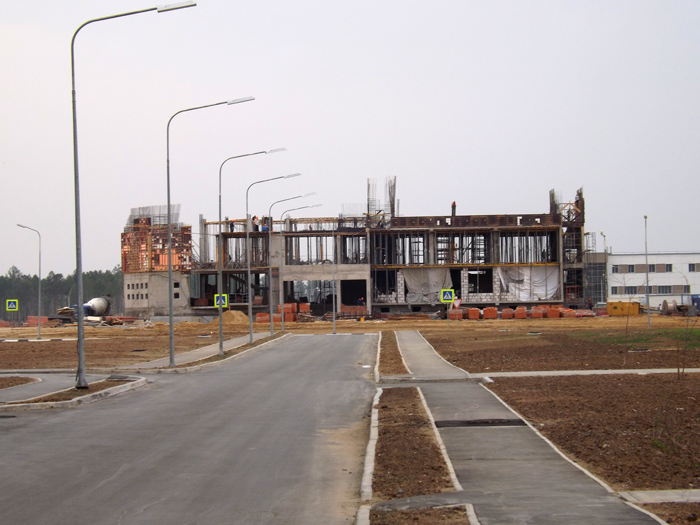
Although at the sites from which the first launch was carried out, there is already a lull.
Go there.
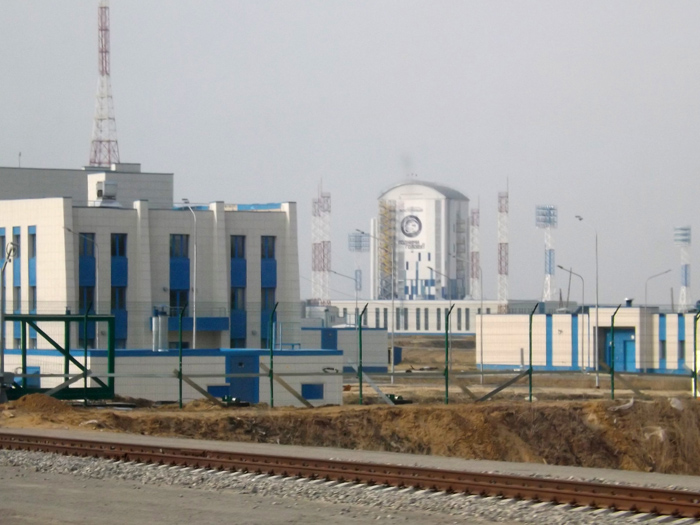

Unfortunately, the support tower completely covered the launching table, we had to remove it from the room, which was not very good without a wide-angle lens. The many levels of service farms create a sense of chaotic clutter that is difficult to deal with unaccustomed.

Only a look from the balances of farm supports turned out to be interesting.

Under the launching table you could still see the consequences of the launch.
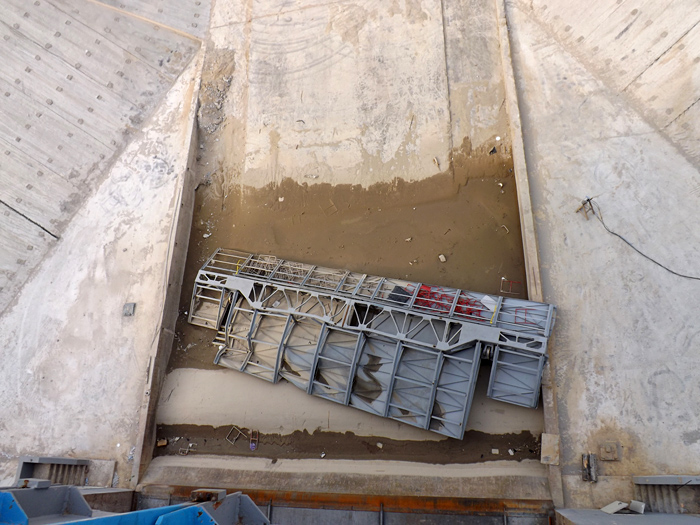
In the photo, the detached flue gas flap looks small, although in reality its size is impressive, and indirectly resembles how powerful it is in the launching rocket.
We arrived at the cosmodrome about a month after the launch, but there was no rush to dismantle the broken structure. On the question of what would be done to her, there was a phlegmatic answer “Then remove”. I offered to dismantle it for souvenirs and for sales to tourists to recapture the cost of the rocket, but the idea of the cosmodrome employees was not impressed.
Work continued at the bottom of the vapor tray. The slots between the plates slowly caulked rubber pads. It seems that they did not have time before start-up, but now, the main thing is to have time before the frost, therefore 2-3 employees should cope during the summer.

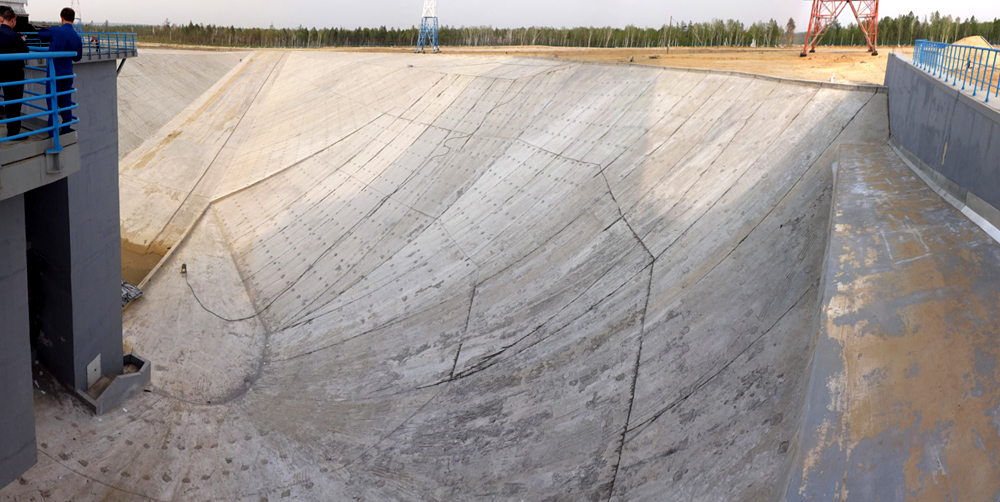
Bypassing the security tower led to a heap of burnt ducts of the temperature control system. Ventilation is used to maintain the required storage conditions of the spacecraft under the head fairing of the rocket. Charging of the prepared air is made until the very start. As a souvenir, I tore off a little duct for myself and now I have a piece of useless plastic, scorched by the fire of the first start from the East. I must say on the plastic there did not save - to tear off a small fragment was not so easy - damn durable.
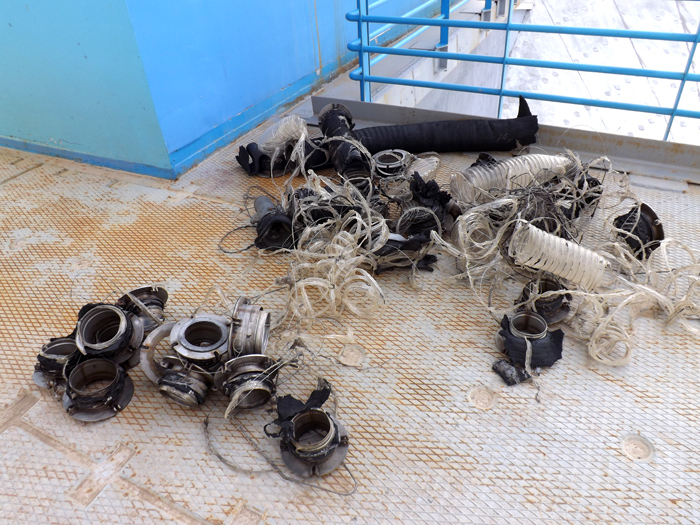
.
And we were led to the launch control bunker.

Now everything is asleep, except for hours.
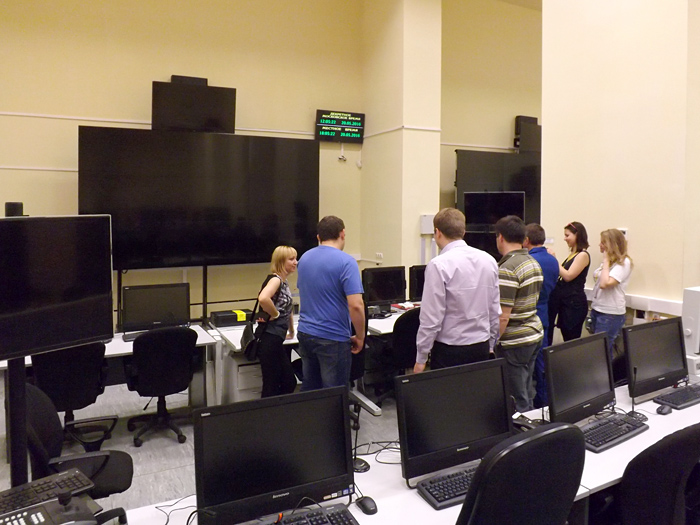
The very key to start.

It can be seen that a lot of Russian-made control electronics, but TVs and monitors are from the nearest hypermarket.

During the tour, we managed to talk with local young specialists, who, after studying at the MAI, returned home to work at the cosmodrome. They were given office apartments in Tsiolkovsky, but every weekend they return to Blagoveshchensk, because there is simply nothing to do in the new city. Salary by local standards is not bad, but less than 50 thousand rubles. The core of the experienced specialists of the East - from Baikonur. They go here on business trips, some plan to move for good. They still lack their own specialists, and they have practically no experience, so the cosmodrome needs work so that they no longer have anything to do at the start.
It is clear that the construction of a cosmodrome is primarily a political task, the solution of which should ensure the independence of Russian astronautics from Kazakhstan. As long as there is Baikonur, and as long as a launch pad for the Angara has not been built at Vostochny, there is no practical need for it, and now launches from Kazakhstan are more profitable and simpler - all the technology has been worked out.
Nevertheless, there is a certain sense in the construction of the East - this is the cosmodrome for the future. Sooner or later, the ISS program will end, and the manned “Unions” will not be needed. Sooner or later the “Proton” will close. Now Baikonur lives only with these two programs that cannot be provided from somewhere else. When they are completed, the “Bike” will come to an end. Russia is not interested in developing infrastructure in the territory of another state for future programs of the future, therefore the Eastern Age will come.
There is also a debatable cost question: Is the Orient the most expensive cosmodrome of our time? We will discuss this separately in the near future, do not switch.
For the tour I express my gratitude to the Department of Public Relations of the United Rocket and Space Corporation.
Source: https://habr.com/ru/post/396173/
All Articles